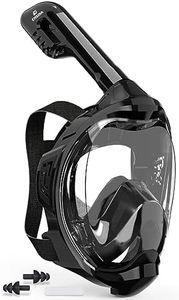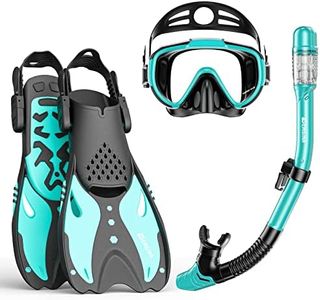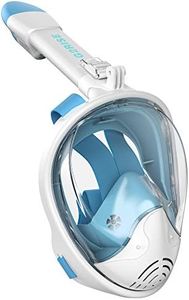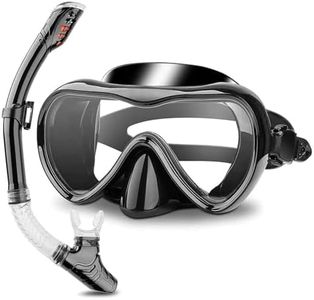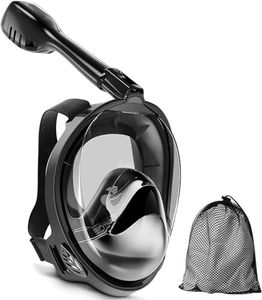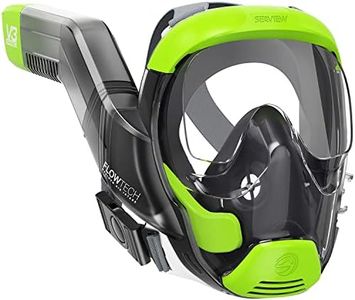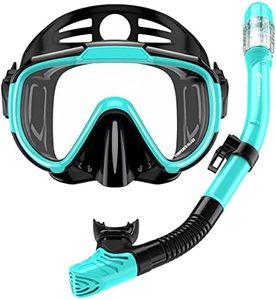We Use CookiesWe use cookies to enhance the security, performance,
functionality and for analytical and promotional activities. By continuing to browse this site you
are agreeing to our privacy policy
10 Best Snorkeling Masks
From leading brands and best sellers available on the web.Buying Guide for the Best Snorkeling Masks
Choosing the right snorkeling mask is important for a comfortable and enjoyable underwater experience. The right mask will provide a clear field of view, prevent water from leaking in, and feel comfortable for extended periods. Each person’s face shape is different, so what fits one person well may not fit another. Understanding the key specifications of snorkeling masks will help you make an informed decision and select a mask that matches your needs and preferences.Fit and SealThe fit and seal of a snorkeling mask refers to how well the mask sits on your face and prevents water from entering. This is one of the most important aspects, as an ill-fitting mask can ruin your experience by constantly leaking. To test fit, gently press the mask to your face without using the strap and inhale through your nose; if the mask stays in place, it likely has a good seal for your face shape. Investigate masks with different skirt shapes and materials—silicone tends to offer a better and longer-lasting seal. Choosing a mask that fits your face snugly, without being too tight, is key to comfort and performance.
Lens Type and VisibilityThe lens of a snorkeling mask is the part you look through, and its type and quality affect how much you can see and how clear the view is. Masks come with single lenses (one large window), dual lenses (divided into two sections), or even multi-window designs for peripheral vision. Tempered glass lenses are durable and resist scratching, while plastic lenses are lighter but may scratch more easily. If you wear glasses, look for masks that can accommodate prescription lenses. Wide and clear lenses are best for enjoying the underwater scenery, so think about your preferences for visibility and comfort.
VolumeVolume refers to the amount of air space inside the mask between your face and the lens. Low-volume masks sit closer to your face, making it easier to clear water and equalize pressure, which is especially important for those who want to dive briefly below the surface. High-volume masks can feel roomier and might offer a wider view, but they are harder to clear if water gets in. Choose low volume if you plan to dive down or want easy clearing, and high volume if comfort and view are your top priorities and you plan to stay near the surface.
Skirt MaterialThe skirt is the soft, flexible part of the mask that touches your face. It is usually made of silicone or rubber, with silicone being more comfortable, durable, and forming a better seal. Transparent skirts can give a brighter, more open feel, while colored skirts limit side glare. Sensitive skin may respond better to higher-grade silicone. Consider your comfort and any skin sensitivities when picking skirt material, aiming for soft silicone for the best long-term experience.
Straps and AdjustabilityStraps keep the mask securely on your face, and adjustability ensures you get the best fit. Modern masks often have wide, easily adjustable straps that distribute pressure evenly. Some have quick-release buckles for fast removal. If you have long hair, look for straps that are less likely to tangle. When choosing, think about how quickly and easily you can adjust the strap while wearing the mask, and pick a design that feels secure but not too tight.
Full-Face vs. Traditional MasksTraditional masks cover your eyes and nose and are used with a separate snorkel, while full-face masks cover your entire face and let you breathe through your nose and mouth. Full-face masks can feel more natural to beginners and prevent jaw fatigue, but they're bulkier, may have issues with CO2 buildup if poorly designed, and are not suited for diving below the surface. Traditional masks offer more flexibility, are simpler, and are better for both surface and light underwater exploration. Think about your comfort, experience, and intended activity when deciding between the two.
